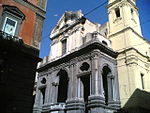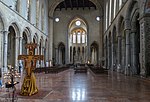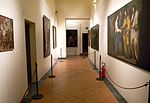Museum of the Treasure of San Gennaro

The Treasure of San Gennaro is composed of art works and donations collected in seven centuries of Popes, Kings, Emperors, famous and ordinary people, kept in a museum in Naples, Italy. According to studies done by a pool of experts who have analyzed all the pieces of the collection, the Treasure of St. Gennaro would be even richer than the crown of England's Queen Elizabeth II and the Czars of Russia. The Treasure is a collection of art works, kept untouched thanks to the Deputation of the Royal Chapel of the Treasure of San Gennaro, an ancient secular institution founded in 1527 by a vote of the city of Naples, still existing. Today, the donations are exhibited in the Museum, whose entrance is located on the right side of the Cathedral of Naples, under the arcades. By visiting the Museum, you can access the Royal Chapel of San Gennaro, where the two ampules containing San Gennaro's Blood are kept in the Major altar. The museum was opened in December 2003 thanks to a project funded by private companies, European funds and local institutions under the patronage of the President Ciampi, on a proposal of the Deputation of the Chapel of the Treasure of San Gennaro, (established in 1601). The curator of the project was the director Paolo Jorio.
Excerpt from the Wikipedia article Museum of the Treasure of San Gennaro (License: CC BY-SA 3.0, Authors, Images).Museum of the Treasure of San Gennaro
Piazza Sisto Riario Sforza, Naples San Lorenzo
Geographical coordinates (GPS) Address Nearby Places Show on map
Geographical coordinates (GPS)
| Latitude | Longitude |
|---|---|
| N 40.852222222222 ° | E 14.259444444444 ° |
Address
Cattedrale di Santa Maria Assunta (Duomo)
Piazza Sisto Riario Sforza
80138 Naples, San Lorenzo
Campania, Italy
Open on Google Maps











